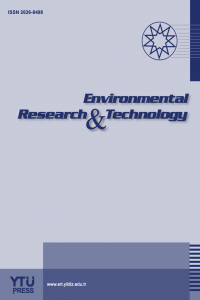Household water consumption behavior during the COVID-19 pandemic and its relationship with COVID-19 cases
The use of existing water resources and sustainability problems as a result of global warming and climate change became an even bigger problem with the importance of hygiene during the COVID-19 pandemic. In this research, the water consumption behavior will be researched and the correlation between water consumption and COVID-19 case numbers will be investigated in Bursa, Turkey. The monthly mean water consumption for 758,500 domicile subscribers using the central tariff from 2018–2020 was calculated. Results obtained using the SPSS 23 IBM program observed a 20.18% increase in water consumption in Bursa in general during COVID-19. As Bursa province has both rural and industrial urban structures, when this increase is examined on a county basis, increase rates were 10% in regions with dense industry and mean 34% in rural areas. When the correlation between case numbers during the COVID-19 period (March 2020-January 2021) and water consumption is examined, a negative correlation is notable (Pearson-Correlation=-0.616). As the case numbers increased in the continuing COVID-19 pandemic, the reduction in water consumption may be explained by warnings to citizens to reduce water use through written and oral media due to reservoir fill rates falling below 5%. These results provide beneficial information revealing the effects of COVID-19 on water consumption behavior and use of water resources in urban and rural areas.
___
- [1] Y. Wei, Z. Wang, H. Wang, T. Yao, and Y. Li, “Promoting inclusive water governance and forecasting the structure of water consumption based on compositional data: A case study of Beijing,” Sci. Total Environ., vol. 634, pp. 407–416, Sep. 2018.
- [2] Q. Wang and X. Wang, “Moving to economic growth without water demand growth -- a decomposition analysis of decoupling from economic growth and water use in 31 provinces of China,” Sci. Total Environ., vol. 726, p. 138362, Jul. 2020.
- [3] B. Bates, Z. Kundzewicz, W. Shaohong, and J. Palutikof, “Climate Change and Water - IPCC Technical Paper of the Intergovernmental Panel on Climate Change,” IPCC Secretariat, Geneva, 2008.
- [4] R. Cooper, “Water security beyond Covid-19,” 2020.
- [5] WWAP(UNESCO World Water Assessment Programme), “The United Nations World Water Development Report 2019: Leaving No One Behind,” Paris, 2019.
- [6] J. T. F. Lau, S. Griffiths, K. C. Choi, and H. Y. Tsui, “Widespread public misconception in the early phase of the H1N1 influenza epidemic,” J. Infect., vol. 59, no. 2, pp. 122–127, Aug. 2009.
- [7] WHO, “WHO | Safer water, better health,” World Health Organization, 2018.
- [8] M. Poch et al., “When the fourth water and digital revolution encountered COVID-19,” Sci. Total Environ., vol. 744, p. 140980, Nov. 2020.
- [9] C. Tortajada and A. K. Biswas, “COVID-19 heightens water problems around the world,” Water Int., vol. 45, 2020.
- [10] G. Balacco, V. Totaro, V. Iacobellis, A. Manni, M. Spagnoletta, and A. F. Piccinni, “Influence of COVID-19 Spread on Water Drinking Demand: The Case of Puglia Region (Southern Italy),” Sustainability, vol. 12, no. 15, p. 5919, Jul. 2020.
- [11] A. K. Amegah, “Improving handwashing habits and household air quality in Africa after COVID-19,” Lancet Glob. Heal., vol. 8, no. 9, pp. e1110–e1111, Sep. 2020.
- [12] R. Roshan, A. S. Feroz, Z. Rafique, and N. Virani, “Rigorous Hand Hygiene Practices Among Health Care Workers Reduce Hospital-Associated Infections During the COVID-19 Pandemic,” J. Prim. Care Community Health, vol. 11, p. 215013272094333, Jan. 2020.
- [13] A. Sayeed et al., “Handwashing with soap: A concern for overuse of water amidst the COVID-19 pandemic in Bangladesh,” Groundw. Sustain. Dev., vol. 13, p. 100561, May 2021.
- [14] A. Sayeed, S. Kundu, M. H. Al Banna, and M. N. Hassan, “COVID-19 outbreak: Water loss during handwashing, need more concern?,” Popul. Med., vol. 2, no. October, pp. 1–2, Oct. 2020.
- [15] A. Kalbusch, E. Henning, M. P. Brikalski, F. V. de Luca, and A. C. Konrath, “Impact of coronavirus (COVID-19) spread-prevention actions on urban water consumption,” Resour. Conserv. Recycl., vol. 163, p. 105098, Dec. 2020.
- [16] D. U. Lüdtke, R. Luetkemeier, M. Schneemann, and S. Liehr, “Increase in Daily Household Water Demand during the First Wave of the Covid‐19 Pandemic in Germany.,” Water, vol. 13, p. 260, 2021.
- [17] H. Cooley, P. H. Gleick, S. Abraham, and W. Cai, “Issue Brief Pacific Institute Water and the COVID-19 Pandemic Impacts on Municipal Water Demand,” 2020.
- [18] L. Eastman, E. Smull, L. Patterson, and M. Doyle, “COVID-19 Impacts on Water Utility Consumption and Revenues PRELIMINARY RESULTS.”
- [19] J. M. Brauner et al., “Inferring the effectiveness of government interventions against COVID-19,” Science (80-. )., p. eabd9338, Dec. 2020.
- [20] DHA-AA-İHA, “Türkiye’yi bekleyen büyük tehlike! Gün geçtikçe düşüyor,” Cnnturk.com.
- [21] S. ŞAHİN and H. ÖZDEMİR, “Bursa’da barajdaki doluluk oranı yüzde 5’e düştü, tarihi köprü ortaya çıktı,” Hurriyet, 2021.
- [22] D. E. ÜNLÜ, “Türkiye, 2021’de su kıtlığı yaşayabilir,” Dünya Gazetesi, 2020.
- [23] D. Li et al., “Stay-at-Home Orders during the COVID-19 Pandemic Reduced Urban Water Use,” Environ. Sci. Technol. Lett., Feb. 2021.
- [24] L. Eastman, E. Smull, L. Patterson, and M. Doyle, “COVID-19 Impacts on Water Utility Consumption and Revenues: Preliminary Results,” 2020.
- [25] J. Cook and L. Makin, “Covid Water Use and the Impact on Poverty in the UK,” 2020.
- [26] M. Memati, “COVİD-19 and Urban Water Consumption,” ARE Updat., vol. 24, no. 1, pp. 9-11 University of California Giannini Foundation, 2020.
- Yayın Aralığı: Yılda 4 Sayı
- Başlangıç: 2018
- Yayıncı: Yıldız Teknik Üniversitesi
Sayıdaki Diğer Makaleler
Juciara LOPES, André ROSA, Izabelle SOUSA, Silas MELO, Antonella ALMEİDA, Alisson BORGES
Samahir A. S. IDRİS, Emel TOPUZ
Zehrudin OSMANOVİC, Nedzad HARACİC, İbrahim SARAJLİC, Amila DUBRAVAC, Eldin HALİLČEVİĆ
Simge SERTGÜMEÇ, Ayşe Nur USTA, Cevat ÖZARPA
Burcu KEKEVİ, Ali EŞLEK, Emine Hilal MERT
Francis James OGBOZİGE, Helen NWOBU
